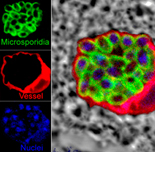 |
  DISEASES WE INVESTIGATE DISEASES WE INVESTIGATE
Microsporidiosis
Overview
Microsporidiosis is an emerging, newly recognized and opportunistic infection of humans that most commonly causes diarrhea and may also cause a wide range of other clinical syndromes. Microsporidiosis, however, has long been recognized to occur in animals.
- Due to a concern for food borne and waterborne transmission to humans, two species of microsporidia have been included on the list of microbial contaminant candidates by the U.S. Environmental Protection Agency, in response to the Safe Drinking Water Act, and on the list of Category B Select Agents by the National Institutes of Health.
- It is estimated that approximately 15% of AIDS patients become infected with microsporidia. Prevalence rates for other groups of individuals are undetermined because diagnostic tests are still difficult to interpret.
- Numbers of deaths due to microsporidiosis are undetermined.
- At risk of developing disease due to microsporidiosis are immune deficient individuals such as persons with AIDS, organ transplant recipients undergoing immunosuppressive therapies, malnourished children, and the elderly. Others at risk include immunologically naïve travelers and contact lens wearers.
- Microsporidiosis occurs world wide in developed and developing countries.
Infectious Agent
- Microsporidia are single-celled parasites that must infect other cells to replicate.
- Over 1,200 species of microsporidia are known to infect vertebrate and invertebrate animals, and 14 species have been reported to infect humans. The two most common species of microsporidia that infect humans, Enterocytozoon bieneusi and Encephalitozoon intestinalis, also infect a wide range of other mammals, which raises concerns for animal to human transmission (and vice versa).
- The infectious stages of Enterocytozoon bieneusi and Encephalitozoon intestinalis are spores which are small oval-shaped organisms that are surrounded by a spore wall to allow their survival in the environment for long periods of time, especially in water sources.
Transmission
- Microsporidiosis is most commonly transmitted by ingestion or inhalation of spores from contaminated food, water, or aerosols. Organisms then initially infect cells lining the small intestine or respiratory tract. Additional speculated modes of transmission include exposure to vectors (e.g. mosquitoes) and sexual contact.
- Infected hosts excrete spores with urine and feces that can potentially contaminate the environment, including drinking and irrigation water sources.
The Disease
- The most commonly reported symptom associated with microsporidiosis in humans is diarrhea that resolves after a few weeks in immune competent individuals and persists in immune deficient people.
- Some species of microsporidia also spread to cause systemic infections that can lead to symptoms such as blurred vision, muscle pain, sinusitis, pneumonia, and encephalitis.
Treatment
- No single drug is effective against all the species of microsporidia that infect humans.
- Albendazole is effective for treating infections due to Encephalitozoon species.
- Fumagillin is being tested for efficacy against Enterocytozoon bieneusi, but this drug is also toxic.
- No vaccines exist for microsporidiosis.
- Prevention strategies include hand washing prior to eating and drinking as well as drinking boiled or distilled water.
Our Research
- A monkey model for Enterocytozoon bieneusi (the most common microsporidian that infects humans) is being used to study the epidemiology, pathogenesis and immunology of microsporidiosis.
- Experiments using tissue culture methods, mice and monkeys are being performed to identify drugs effective against several species of microsporidia that infect humans and animals.
- Methods are being developed to more reliably capture and identify microsporidia in water sources that may pose a risk for transmission to humans and animals.
- Diagnostic methods are being developed and applied to more accurately determine the prevalence of microsporidiosis in humans.
|
 |


